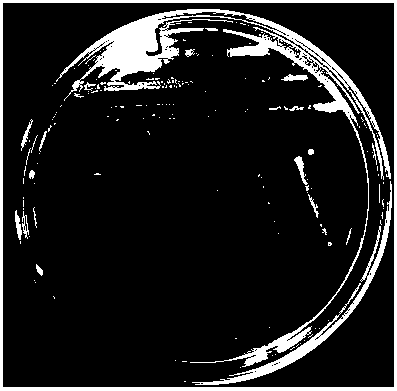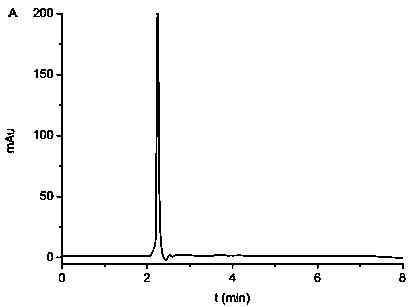A strain capable of degrading soil residual quinclorac
A technology of quinclorac and bacterial strains, which is applied in the field of microbial treatment of environmental pollution, can solve the problems of tobacco production and output value reduction, and achieve the effects of reducing economic losses and protecting the environment
- Summary
- Abstract
- Description
- Claims
- Application Information
AI Technical Summary
Problems solved by technology
Method used
Image
Examples
Embodiment 1
[0026] Example 1 Screening of bacterial strain J7
[0027] In this experiment, the soil was collected from the tobacco field, and the enrichment method was used to screen the microbial strains that could degrade quinclorac. The process was as follows: figure 1 shown. In this test, a strain that can degrade quinclorac in soil was screened and named J7; the screening process is as follows:
[0028] (1) Enrichment of quinclorac-degrading bacteria: Mix 0.1 g of soil with 100 ml MM medium, add quinclorac to make the final concentration 100 µg / ml, and culture at 30°C, 150 r / min 1 week; take 1 ml of the culture solution and add it to 100 ml of fresh medium containing the same concentration of herbicide, and at the same time streak the solid medium to confirm the growth of bacteria, and cultivate under the same conditions for 1 week; after 10 consecutive subcultures, the Streak the plates to obtain single colony strains. The bacterium is a gram-negative bacterium, the colony is li...
Embodiment 2
[0034] Example 2 Molecular identification
[0035]Using the bacterial 16S rDNA universal primer fD2 / rP1, the 16s rDNA of the strain was amplified by colony PCR and sequenced for comparative analysis to identify the strain:
[0036] fD2: 5'-AGAGTTTGATCATGGCTCAG-3',
[0037] rP1: 5'-ACGGTTACCTTGTTACGACTT-3';
[0038] PCR reaction system: The PCR reaction system is: 1×PCR MIX reaction solution (Quanshijin Biotechnology Co., Ltd., Beijing), 0.4 μM primers, and use a toothpick to pick a small number of colonies as templates;
[0039] PCR reaction program: 32 cycles of pre-denaturation at 95°C for 4 min, each cycle including denaturation at 95°C for 30 s, annealing at 58°C for 30 s, and extension at 72°C for 1 min; finally, extension at 72°C for 10 min.
[0040] The PCR product J7-16S rDNA was verified by agarose gel electrophoresis, and DNA was recovered and sequenced, and the sequencing results were compared with the Genbank database. The results show that the sequence of the s...
Embodiment 3
[0041] Example 3 Tobacco Seedling Experiment: Control Effect of Bacterial Strain J7
[0042] (1) Determination of the concentration of phytotoxicity caused by the medicinal liquid in the soil to the tobacco seedlings: prepare nutrient soil containing 0, 0.001, 0.01 and 0.1 µg / g quinclorac liquid respectively, stir evenly and put the same amount into the flowerpot , transplanted into tobacco seedlings with similar growth conditions, observed the growth of tobacco after 40 days, and measured parameters such as plant height, leaf area and leaf number of tobacco seedlings. Each treatment was repeated 5 times. The results showed that when quinclorac was 0.001 μg / g soil, the phytotoxicity was not obvious; when quinclorac was 0.01 μg / g and 0.1 μg / g soil, the phytotoxicity was obvious ( Image 6 ). Phytotoxicity is mainly manifested in the reduction of leaf area, and at the same time has a certain impact on plant height, but has no obvious inhibitory effect on leaf number ( Figure...
PUM
 Login to View More
Login to View More Abstract
Description
Claims
Application Information
 Login to View More
Login to View More - R&D
- Intellectual Property
- Life Sciences
- Materials
- Tech Scout
- Unparalleled Data Quality
- Higher Quality Content
- 60% Fewer Hallucinations
Browse by: Latest US Patents, China's latest patents, Technical Efficacy Thesaurus, Application Domain, Technology Topic, Popular Technical Reports.
© 2025 PatSnap. All rights reserved.Legal|Privacy policy|Modern Slavery Act Transparency Statement|Sitemap|About US| Contact US: help@patsnap.com



